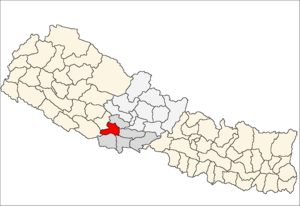Arghakhanchi District facts for kids
Quick facts for kids
Arghākhānchī Jillā
अर्घाखाँची जिल्ला |
|
|---|---|

Location of Arghakhanchi in Nepal
|
|
| Country | Nepal |
| Region | Western (Pashchimanchal) |
| Zone | Lumbini |
| Headquarters | Sandhikharka |
| Area | |
| • Total | 1,193 km2 (461 sq mi) |
| Population
(2011)
|
|
| • Total | 197,632 |
| • Density | 165.66/km2 (429.06/sq mi) |
| Time zone | UTC+5:45 (NPT) |
| Main language(s) | Nepali |
Arghakhanchi (Nepali: अर्घाखाँची जिल्ला) is a district in Nepal. It is located in the Lumbini Zone, which is part of Nepal's western region. The main administrative center, or district headquarters, for Arghakhanchi is a town called Sandhikharka.
Contents
What is Arghakhanchi?
Arghakhanchi is one of the 77 districts that make up the country of Nepal. Think of a district like a county or a smaller state within a country. It's a place where many people live and work, and it has its own local government.
Where is Arghakhanchi Located?
This district is found in the western part of Nepal. Nepal is a country known for its amazing mountains, hills, and flat plains. Arghakhanchi is mostly a hilly area, which means it has lots of slopes and valleys. It's part of the Lumbini Zone, which is famous for being the birthplace of Buddha.
How Many People Live There?
According to a count done in 2011, about 197,632 people live in Arghakhanchi. The district covers an area of 1,193 square kilometers. This means that for every square kilometer, there are about 166 people. That's how we figure out how crowded or spread out a place is!
What Language Do They Speak?
The main language spoken by most people in Arghakhanchi is Nepali. This is also the official language of Nepal.
What is Sandhikharka?
Sandhikharka is the "headquarters" of Arghakhanchi District. This means it's the most important town in the district for government and administration. It's where the main offices are, and where decisions for the district are often made.
History of Arghakhanchi
Arghakhanchi District was officially established in 1962. Before that, Nepal's administrative divisions were different. This change helped organize the country better and made it easier to manage local areas.
See Also

